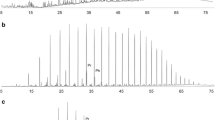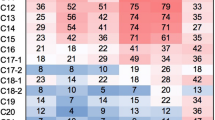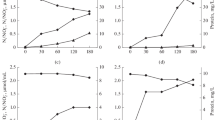Abstract
The aim of this study was to characterize and compare the bacterial community structure of two distinct oil samples from a petroleum field in Brazil by using both molecular, based on the construction of 16S rRNA gene libraries, and cultivation methods. Statistical comparisons of libraries based on Amplified Ribosomal DNA Restriction Analysis (ARDRA) data revealed no significant differences between the communities recovered in the non-biodegraded (NBD) and highly biodegraded oils (HBD). BlastN analysis of the 16S rRNA gene sequences representative of distinct ribotypes from both oils showed the presence of nine different bacterial genera in these samples, encompassing members of the genera Arcobacter, Halanaerobium, Marinobacter, Propionibacterium, Streptomyces, Leuconostoc, Acinetobacter, Bacillus and Streptococcus. Enrichments obtained using oil as inoculum and sole carbon source yielded bacterial isolates showing high 16S rRNA gene sequence similarity with Achromobacter xylosoxidans, Bacillus subtilis, Brevibacillus sp., Dietzia sp. and Methylobacterium sp. Comparison between the data obtained using cultivation-independent and enrichment cultures suggests that different selection of community members may occur when using distinct approaches. All the organisms found, except for Leuconostoc sp. and Streptococus sp., have been previously reported in the literature as hydrocarbon degraders and/or associated to oil field environments.




Similar content being viewed by others
References
Al-Sharidah A, Richardt A, Golecki JR, Dierstein R, Tadros MH (2000) Isolation and characterization of two hydrocarbon-degrading Bacillus subtilis strains from oil contaminated soil of Kuwait. Microbiol Res 155:157–164
Asmus HE, Ponte FC (1973) The Brazilian marginal basins. In: Nairn AE, Sthli FG (eds) The ocean basins and margins, vol. 1, South Atlantic, Plenun Press, New York, pp 87–133
Bach H, Berdichevsky Y, Gutnick D (2003) An exocellular protein from the oil-degrading microbe Acinetobacter venetianus RAG-1 enhances the emulsifying activity of the polymeric bioemulsifier emulsan. Appl Environ Microbiol 69:2608–2615
Bachoon DS, Araujo R, Molina M, Hodson RE (2001) Microbial community dynamics and evaluation of bioremediation strategies in oil-impacted salt marsh sediment microcosms. J Ind Microbiol Biotechnol 27:72–79
Barbeau K, Zhang G, Live DH, Butler A (2002) Petrobactin, a photoreactive siderophore produced by the oil-degrading marine bacterium Marinobacter hydrocarbonoclasticus. J Am Chem Soc 124:378–379
Barkovskii AL, Shub GM (1986) Acinetobacter calcoaceticus strain with a wide spectrum of utilizing aromatic compounds and carrying a plasmid for resorcin degradation. Mikrobiologiia 55(2):237–240
Batrakov SG, Rodionova TA, Esipov SE, Polyakov NB, Sheichenko VI, Shekhovtsova NV, Lukin SM, Panikov NS, Nikolaev YA (2003) A novel lipopeptide, an inhibitor of bacterial adhesion, from the thermophilic and halotolerant subsurface Bacillus licheniformis strain 603. Biochim Biophys Acta 1634(3):107–150
Behlülgil K, Mehmetogelu MT (2002) Bacteria for improvement of oil recovery: a laboratory study. Energy Sources 24:413–421
Bieszkiewicz E, Horoch M, Boszczyk-Maleszak H, Mycielski R (1998) An attempt to use selected strains of bacteria adapted to high concentrations of petroleum oil to increase the effective removal of petroleum products in excess activated sludge in laboratory conditions. Acta Microbiol Pol 47:305–312
Bhupathiraju VK, Oren A, Sharma PK, Tanner RS, Woese CR, McInerney MJ (1994) Haloanaerobium salsugo sp. nov., a moderately halophilic, anaerobic bacterium from a subterranean brine. Int J Syst Bacteriol 44(3):565–572
Bonch-Osmolovskaya EA, Miroshnichenko ML, Lebedinsky AV, Chernyh NA, Nazina TN, Ivoilov VS, Belyaev SS, Boulygina ES, Lysov YP, Perov AN, Mirzabekov AD, Hippe H, Stackebrandt E, L’Haridon S, Jeanthon C (2003) Radioisotopic, culture-based, and oligonucleotide microchip analyses of thermophilic microbial communities in a continental high-temperature petroleum reservoir. Appl Environ Microbiol 69:6143–6151
Chaillan F, Le Fleche A, Bury E, Phantavong YH, Grimont P, Saliot A, Oudot J (2004) Identification and biodegradation potential of tropical aerobic hydrocarbon-degrading microorganisms. Res Microbiol 155:587–595
Chandler DP, Shu-Mei L, Spadoni CM, Drake GR, Balkwill DL, Fredrickson JK, Brockman FJ (1997) A molecular comparison of culturable aerobic heterotrophic bacteria and 16S rDNA clones derived from a deep subsurface sediment. FEMS Microbiol Ecol 23:131–144
Connan J (1984) In: Brooks J, Welte DH (eds) Advances in petroleum geochemistry, vol 1. Academic, London, pp 299–335
Damelin LH, Dykes A, von Holy A (1995) Biodiversity of lactic acid bacteria from food-related ecosystems. Microbios 83:13–22
DeLong EF (1992) Archaea in coastal marine environments. Proceedings of the Natural Academy of Sciences USA 89:5685–5689
Doumenq P, Aries E, Asia L, Acquaviva M, Artaud J, Gilewicz M, Mille G, Bertrand JC (2001) Influence of n-alkanes and petroleum on fatty acid composition of a hydrocarbonoclastic bacterium: Marinobacter hydrocarbonoclasticus strain 617. Chemosphere 44:519–528
Eilers H, Pernthaler J, Glockner FO, Amann R (2000) Culturability and in situ abundance of pelagic bacteria from the North Sea. Appl Environ Microbiol 66(7):3044–3051
Gauthier MJ, Lafay B, Christen R, Fernandez L, Acquaviva M, Bonin P, Bertrand JC (1992) Marinobacter hydrocarbonoclasticus gen. nov., sp. nov., a new, extremely halotolerant, hydrocarbon-degrading marine bacterium. Int J Syst Bacteriol 42(4):568–576
Gevertz D, Telang AJ, Voordouw G, Jenneman GE (2000) Isolation and characterization of strains CVO and FWKO B, two novel nitrate-reducing, sulfide-oxidizing bacteria isolated from oil field brine. Appl Environ Microbiol 66(6):2491–2501
Gotelli NJ, Entsminger GL (2003) EcoSim: null models software for ecology. Acquired Intelligence Inc. & Kesey-Bear, Burlington, VT 05465
Guardado LR, Gamboa LAP, Lucchesi CF (1989) Petroleum geology of the Campos Basin, Brazil, a model for a producing Atlantic type basin. In: Edwards JD, Santogrossi PA (eds) Divergent/passive margin basins, AAPG Memoir 48, 3–79
Head IM, Jones DM, Larter SR (2003) Biological activity in the deep subsurface and the origin of heavy oil. Nature 426:344–352
Hugenholtz P, Goebel BM, Pace NR (1998) Impact of culture-independent studies on the emerging phylogenetic view of bacterial diversity. J Bacteriol 180:4765–4774
Huu NB, Denner EB, Ha DT, Wanner G, Stan-Lotter H (1999) Marinobacter aquaeolei sp. nov., a halophilic bacterium isolated from a Vietnamese oil-producing well. Int J Syst Bacteriol 49(2):367–375
Jahnert R, França A, Trindade LAF, Quintaes C, Santos P, Pessoa J, Bedregal RP (1998) The petroleum system of Campos Basin. BGP; AAPG International Conference & Exhibition, November 8–11, 1998, Rio de Janeiro, Brasil. Extended abstracts volume, 600–601
Jarvis GN, Strompl C, Moore ER, Thiele JH (1998) Isolation and characterisation of obligately anaerobic, lipolytic bacteria from the rumen of red deer. Syst Appl Microbiol 21:135–143
Juck D, Charles T, Whyte LG, Greer CW (2000) Polyphasic microbial community analysis of petroleum hydrocarbon-contaminated oils from two northern Canadian communities. FEMS Microbiol Ecol 33:241–249
Kimura M (1980) A simple method for estimating evolutionary rate of base substitutions through comparative studies of nucleotide sequences. J Mol Evol 16:111–120
Lane DJ (1991) 16S/23S rRNA Sequencing. In: Stackebrandt E, Goodfellow M (eds) Nucleic acid techniques in bacterial systematics. John Wiley & Sons, Chichester, England, pp 115–175
Larter S, Wilhelms A, Head IM, Koopmans M, Aplin R, Di Primio R, Zwach C, Erdmann M, Telnaes N (2003) The controls on the composition of biodegraded oils in the deep subsurface – part 1: biodegradation rates in petroleum reservoirs. Org Geochem 34:601–613
Larter S, Huang H, Adams J, Bennett B, Jokanola O, Oldemburg T, Jones M, Head I, Riediger C, Fowler M (2006) The controls on the composition of biodegraded oils in the deep subsurface – part II: geological controls on subsurface biodegradation fluxes and constraints on reservoir fluid property prediction. AAPG Bull 90:921–938
Lu XX, Zhang X, Li GH, Zhang WH (2003) Production of biosurfactant and its role in the biodegradation of oil hydrocarbons. J Environ Sci Health A Tox Hazard Subst Environ Eng 38:483–492
Magot M, Ollivier B, Patel BKC (2000) Microbiology of petroleum reservoirs. Ant Van Leeuwen 77:103–116
Mohiak WU, Mello MR, Karner GD, Dewey JF, Maxwell JR (1989) Structural and stratigraphic evolution of the Campos Basin, offshore Brazil. Extentional Tectonics and Stratigraphy of North Atlantic Margins: Analogs, AAPG Memoir 46:577–598
Munson MA, Nedwell DB, Embley TM (1997) Phylogenetic diversity of Archaea in sediment samples from a coastal salt marsh. Appl Environ Microbiol 63:4729–4733
Nazina TN, Grigor’ian AA, Sue KF, Sokolova DSh, Novikova EV, Turova TP, Poltaraus AB, Beliaev SS, Ivanov MV (2002) Phylogenetic diversity of aerobic saprotrophic bacteria isolated from the Daqing oil field. Mikrobiologiia 71:103–110
Orphan VJ, Taylor LT, Hafenbradl D, Delong EF (2000) Culture-dependent and culture-independent characterization of microbial assemblage associated with high temperature petroleum reservoirs. Appl Environ Microbiol 66:700–711
Pace NR (1996) New perspective on the natural microbial world: molecular microbial ecology. ASM News 62:463–470
Peters KE, Moldowan JM (1993) The Biomarkers Guide. Prentice-Hall, New York, 363 pp
Pettersson B, Lembke F, Hammer P, Stackebrandt E, Priest FG (1996) Bacillus sporothermodurans, a new species producing highly heat-resistant endospores. Int J Syst Bacteriol 46(3):759–764
Pineda-Flores G, Boll-Arguello G, Lira-Galeana C, Mesta-Howard AM (2004) A microbial consortium isolated from a crude oil sample that uses asphaltenes as a carbon and energy source. Biodegradation 15:145–151
Pleshakova EV, Muratova AIu, Turkovskaia OV (2001) Degradation of mineral oil by Acinetobacter calcoaceticus strain. Prikl Biokhim Mikrobiol 37:398–404
Ponte FC, Asmus HE (1978) Geological framework of the Brazilian continental margin. Geol Rundsch 67:201–235
Radwan SS, Sorkhoh NA, Fardoun F, Al-Hasan RH (1995) Soil management enhancing hydrocarbon biodegradation in the polluted Kuwaiti desert. Appl Microbiol Biotechnol 44(1–2):265–270
Radwan SS, Barabas G, Sorkhoh NA, Damjanovich S, Szabo I, Szollosi J, Matko J, Penyige A, Hirano T, Szabo IM (1998) Hydrocarbon uptake by Streptomyces. FEMS Microbiol Lett 169(1):87–94
Rainey FA, Ward-Reiney N, Kroppenstedt RM, Stackebrandt E (1996) The genus Nocardiopsis represents a phylogenetically coherent taxon and a distinct actinomycete lineage: Proposal of Nocardiopsaceae fam. nov. Int J Syst Bacteriol 46:1088–1092
Rangel HD, Martins FAL, Esteves FR, Feijó FJ (1994) Bacia de Campos. Boletim de Geociências da Petrobras 8(1):203–217
Ravot G, Magot M, Ollivier B, Patel BK, Ageron E, Grimont PA, Thomas P, Garcia JL (1997) Haloanaerobium congolense sp. nov., an anaerobic, moderately halophilic, thiosulfate- and sulfur-reducing bacterium from an African oil field. FEMS Microbiol Lett 147(1):81–88
Saadoun I (2002) Isolation and characterization of bacteria from crude petroleum oil contaminated soil and their potential to degrade diesel fuel. J Basic Microbiol 42:420–428
Sambrook J, Fritsch EF, Maniatis T (1989) Small-scale preparations of plasmid DNA. In: Molecular cloning: a laboratory manual, 2nd edn., vol 1. Cold Spring Harbor Laboratory Press, Plainview, NY, pp 25–30
Schink B (1997) Energetics of syntrophic cooperation in methanogenic degradation. Microbiol Mol Biol Rev 61:262–280
Stapleton RD, Bright NG, Sayler GS (2000) Catabolic and genetic diversity of degradative bacteria from fuel-hydrocarbon contaminated aquifers. Microb Ecol 39(3):211–221
Stephen JR, McCaig AE, Smith Z, Prosser JI, Embley TM (1996) Molecular diversity of soil and marine 16S rRNA gene sequences related to beta-subgroup ammonia-oxidizing bacteria. Appl Environ Microbiol 62:4147–4154
Stiles ME, Holzapfel WH (1997) Lactic acid bacteria for foods and their current taxonomy. Review article Int J Food Microbiol 36:1–29
Sugimori D, Nakamura M, Mihara Y (2002) Microbial degradation of lipid by Acinetobacter sp. strain SOD-1. Biosci Biotechnol Biochem 66(7):1579–1582
Swofford DL (2000) PAUP*. Phylogenetic Analysis Using Parsimony (*and other methods). Sinauer Associates, Sunderland, MA
Takami H, Inoue A, Fuji F, Horikoshi K (1997) Microbial flora in the deepest sea mud of the Mariana Trench. FEMS Microbiol Lett 152:279–285
Tanaka Y, Sogabe M, Okumura K, Kurane R (2002) A highly selective direct method of detecting sulphate-reducing bacteria in crude oil. Lett Appl Microbiol 35:242–246
Teske A, Sigalevich P, Cohen Y, Muyzer G (1996) Molecular identification of bacteria from a coculture by denaturing gradient gel electrophoresis of 16S ribosomal DNA fragments as a tool for isolation in pure cultures. Appl Environ Microbiol 62(11):4210–4215
Thamdrup B, Rossello-Mora R, Amann R (2000) Microbial manganese and sulfate reduction in Black Sea shelf sediments. Appl Environ Microbiol 66(7):2888–2897
Thompson JD, Higgins DG, Gibson TJ (1994) CLUSTALW: improving the sensitivity of progressive multiple sequence alignment through sequence weighting, position specific gap penalties and weight matrix choice. Nucleic Acids Res 22:4673–4680
Tyrrell GJ, Lovgren M, Kress B, Grimsrud K (2005) Invasive Group A streptococcal disease in Alberta, Canada, 2000–2002. J Clin Microbiol 43:1678–1683
Van Hamme JD, Singh A, Ward OP (2003) Recent advances in petroleum microbiology. Microbiol. Mol. Biol. Rev. 67:503–549
Vepritskiy AA, Vitol IA, Nierzwicki-Bauer SA (2002) Novel group I intron in the tRNA(Leu)(UAA) gene of a gamma-proteobacterium isolated from a deep subsurface environment. J Bacteriol 184:1481–1487
von Wintzingerode F, Goebel UB, Stackebrandt E (1997) Determination of microbial diversity in environmental samples: pitfalls of PCR-based rRNA analysis. FEMS Microbiol Rev 21:219–233
Vorob’eva LI, Kraeva NI, Ebringer L, Ol’sinskaia NL (1979) n-Alkane oxidation by propionic acid bacteria. Mikrobiologiia 48:33–38
Voordouw G, Armstrong SM, Reimer MF, Fouts B, Telang AJ, Shen Y, Gevertz D (1996) Characterization of 16S rRNA genes from oil field microbial communities indicates the presence of a variety of sulfate-reducing, fermentative, and sulfide-oxidizing bacteria. Appl. Environ. Microbiol. 62:1623–1629
Watanabe K, Watanabe K, Kodama Y, Syutsubo K, Harayama S (2000) Molecular characterization of bacterial populations in petroleum-contaminated groundwater discharged from underground crude oil storage cavities. Appl Environ Microbiol 66:4803–4809
Watanabe K, Kodama Y, Hamamura N, Kaku N (2002) Diversity, abundance, and activity of archaeal populations in oil-contaminated groundwater accumulated at the bottom of an underground crude oil storage cavity. Appl Environ Microbiol 68:3899–3907
Yoshida N, Yagi K, Sato D, Watanabe N, Kuroishi T, Nishimoto K, Yanagida A, Katsuragi T, Kanagawa T, Kurane R, Tani Y (2005) Bacterial communities in petroleum oil in stockpiles. J Biosci Bioeng 99:143–149
Young A, Blakesley R (1991) Sequencing plasmids form single colonies with the dsDNA cycle sequencing system. Focus 13:13
Zhuang WQ, Tay JH, Maszenan AM, Krumholz LR, Tay ST (2003) Importance of Gram-positive naphthalene-degrading bacteria in oil-contaminated tropical marine sediments. Lett Appl Microbiol 36:251–257
Acknowledgments
L.D. Sette was supported by grants from CNPq Conselho Nacional de Desenvolvimento Científico e Tecnológico, Brazil. We thank to PETROBRAS for the financial support and authorization to publish this work, to J.R. Cerqueira for his insightful suggestions, and to Dr. Fernanda F. Piza for the critical reading.
Author information
Authors and Affiliations
Corresponding author
Rights and permissions
About this article
Cite this article
Sette, L.D., Simioni, K.C.M., Vasconcellos, S.P. et al. Analysis of the composition of bacterial communities in oil reservoirs from a southern offshore Brazilian basin. Antonie van Leeuwenhoek 91, 253–266 (2007). https://doi.org/10.1007/s10482-006-9115-5
Received:
Accepted:
Published:
Issue Date:
DOI: https://doi.org/10.1007/s10482-006-9115-5




